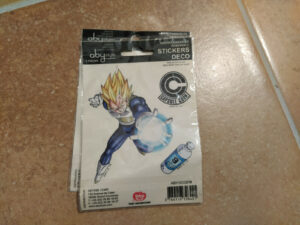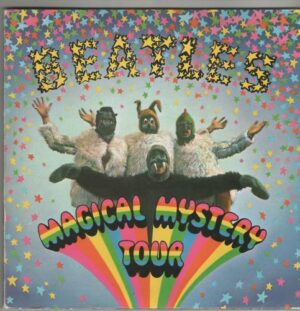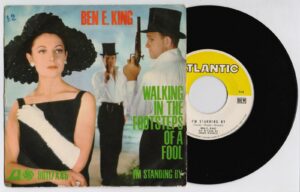Descrizione
|
PREMESSA: LA SUPERIORITA’ DELLA MUSICA SU VINILE E’ ANCOR OGGI SANCITA, |
THE PAUL BUTTERFIELD BLUES BAND
east – west
Disco LP 33 giri , 1966 , this is 1983 reissue , elektra / wea italiana, W 42006, italia
ECCELLENTI CONDIZIONI, vinyl ex++/NM , cover ex++/NM
Paul Butterfield (Chicago,
17
dicembre 1942
– Hollywood,
4
maggio 1987)
è stato un armonicista e cantante
statunitense.
È stato uno dei primi esponenti bianchi
del Chicago Blues. Il suo
stile incisivo e rivoluzionario è ancora oggi un punto di riferimento
per grandi armonicisti moderni come Mark Ford e Andy Just.
Sebbene sia stato uno dei musicisti più innovativi e significativi
del suo tempo, e pur avendo suonato con personaggi del calibro di Jimi
Hendrix, John Mayall, Eric
Clapton, Stevie Ray Vaughan, Muddy
Waters, Bob Dylan, è un artista relativamente poco conosciuto.

Con la forza strumentale dei due chitarristi, East-West , secondo lavoro della Paul Butterfield Blues Band , realizzato nel 1966, desta
sensazione per il forte impatto ma anche per la presenza di due lunghi
brani, insoliti per il blues: East West, soprattutto, stupisce
per gli innesti di psichedelia, progressioni jazzistiche e scale
indiane. È uno dei dischi più importanti del blues bianco elettrico.
East-West is a 1966 album by The Paul Butterfield Blues Band which was the group’s
second full album release. The record’s title track is a long improvisational instrumental
piece inspired by blues, jazz
fusion and raga
that was considered
groundbreaking at the time of release, and over four decades later
stands out as a turning point in the history of rock and blues music. The
album contains another lengthy blues/jazz/rock instrumental in the tune
“Worksong”, which also features extended solos by Butterfield and his
bandmates.
Like the debut, the album
features traditional blues covers
and the guitar work of Elvin
Bishop and Mike Bloomfield, the latter having just
recorded Highway 61 Revisited with Bob
Dylan.
Bishop makes his recorded lead vocal debut on the slow ballad “Never
Say No”. “Mary, Mary“, written by Michael Nesmith, would later be recorded by The
Monkees.
The tune “East-West” in
music history
In 1996, former Butterfield Blues Band member Mark
Naftalin (keyboards), who recorded on the album and is pictured on
the cover of East-West, released a CD on his own ‘Winner’ label
entitled East-West Live, comprising three extended live
performance versions of the tune “East-West”. Noted music critic and
prolific author Dave Marsh contributed a substantial essay in the
liner notes regarding the historic importance of the song, both the
original 1966 recording and the live versions.
Marsh, interviewing Naftalin, notes that the tune was inspired by an
all-night LSD trip that “East-West”‘s primary songwriter
Mike Bloomfield experienced in the fall of 1965, during which the late
guitarist “said he’d had a revelation into the workings of Indian
music.”
Marsh’s expansive liner notes observe that the song “East-West” “was
an exploration of music that moved modally, rather than through chord
changes. As Naftalin explains, “The song was based, like Indian music,
on a drone. In Western musical terms, it ‘stayed on the one’. The song
was tethered to a four-beat bass pattern and structured as a series of
sections, each with a different mood, mode and color, always underscored
by the drummer, who contributed not only the rhythmic feel but much in
the way of tonal shading, using mallets as well as sticks on the various
drums and the different regions of the cymbals. In addition to playing
beautiful solos, Paul [Butterfield] played important, unifying things
[on harmonica] in the background – chords, melodies, counterpoints,
counter-rhythms. This was a group improvisation. In its fullest form it
lasted over an hour.”
In his summation, Marsh points out that “‘East-West’ can be heard as
part of what sparked the West Coast’s rock revolution, in which such
song structures with extended improvisatory passages became
commonplace.”
Going on to call the Butterfield Blues Band “one of the greatest
bands of the rock era”, Marsh concludes that “With ‘East-West’, above
any other extended piece of the mid-Sixties, a rock band finally
achieved a version of the musical freedom that free
jazz had found a few years earlier.”
- Interprete: Butterfield Blues Band
- Etichetta: Elektra / Wea italiana
- Catalogo: W 42006
- Data di pubblicazione: 1983
- Matrici : W – 42006 – BIS – A / W – 42006 – BIS – B
- Supporto:vinile 33 giri:
- Tipo audio: stereo
- Dimensioni: 30 cm.
- Facciate: 2
- Butterfly label, white paper inner sleeve
If the Butterfield Blues Band’s groundbreaking debut earned the respect
of the group’s elder influences, this one won over (and guided) the
blues boys’ psychedelic peers. Highlighted by the 13-minute-plus title
track (an Eastern-influenced jam cowritten by guitarist Mike
Bloomfield), East-West stretches the boundaries of the blues. It
would prod many lesser groups to explore, with generally dreary results,
interminable free-flight explorations. But while East-West and a
cover of jazzman Cannonball Adderly’s “Work Song” ventured in new
directions, Paul Butterfield and company remained rooted in solid
Chicago blues. East West presents the best of both worlds.
1966’s East-West, the second album from the Butterfield Blues
Band — and their last with lead guitarist Mike Bloomfield — found the
group branching out from the electric blues and adding elements of
modern jazz and the music of India, most notably on the landmark title
track, which paved the way for much of the musical experimentation of
the late ’60s.
Track Listings
Side One
- “Walkin’ Blues” (Robert Johnson) – 3:15
- “Get Out of My Life, Woman” (Allen Toussaint) – 3:13
- “I Got a Mind to Give up Living ” (Traditional) – 4:57
- “All These Blues” (Traditional) – 2:18
- “Work Song” (Nat Adderley, Oscar
Brown) – 7:53 order of solos : Bloomfield – Butterfield –Naftalin – Bishop
Side Two
- “Mary, Mary” (Michael Nesmith) – 2:48
- “Two Trains Running” (Muddy
Waters) – 3:50 - “Never Say No” (Traditional) – 2:57
- “East-West” (Mike Bloomfield, Nick Gravenites) – 13:10 order of solos : Bishop – Butterfield – Bloomfield
Personnel :
- Paul Butterfield – Harmonica
and vocals - Mike Bloomfield – Guitar
- Elvin Bishop – Guitar and vocal on “Never Say No”
- Mark Naftalin – keyboards
- Jerome Arnold – Bass Guitar
- Billy Davenport – drums

The second Butterfield album had an even greater effect on music
history, paving the way for experimentation that is still being explored
today. This came in the form of an extended blues-rock solo (some 13
minutes) — a real fusion of jazz and blues inspired by the Indian raga.
This groundbreaking instrumental was the first of its kind and marks
the root from which the acid rock tradition emerged.
Mike Bloomfield fu uno dei musicisti bianchi che cambiarono la scena
blues di Chicago. Si era fatto le ossa, giovanissimo,
nella Butterfield Blues Band (Elektra, 1965)
di Paul Butterfield, armonicista
nato e cresciuto in mezzo ai neri del South Side di Chicago.
Su quell’album storico, che diede il la` al blues revival,
Bloomfield
invento` una tecnica mai sentita prima alla chitarra, una tecnica che,
per gli assoli lunghi e insistiti e per i richiami ai raga, avrebbe
esercitato
un’influenza enorme su tutti i chitarristi successivi.
Del gruppo facevano parte i giovani Elvin Bishop e Mark Naftalin.
East West (Elektra, 1966) e` piu` sperimentale e contiene la
lunga jam
East-West, che ambiva a fondere musica nera e musica indiana
al fuoco catalizzante dell’improvvisazione free-jazz.
Questi due dischi impostarono il blues revival negli USA su basi
completamente
diverse da quelle dei complessi britannici (come John Mayall) che erano
rimasti
fermi agli anni ’50. Butterfield e Bloomfield erano cresciuti ascoltando
il
blues degli anni ’60 e presero il volo da quello stile molto piu`
elettrico e
incalzante (Buddy Guy, Otis Rush, etc).
Butterfield registro` un altro album d’eccezione senza Bloomfield,
The Resurrection Of Pigboy Crabshaw (Elektra, 1968), in uno stile
pop-jazz (David Sanborn al sax) sulla falsariga degli Electric Flag che
Bloomfield aveva appena formato a San Francisco.
(Butterfield morira` nel 1987).

Figlio di un avvocato, dopo aver studiato flauto da
giovane, sviluppò un amore per l’armonica blues, e a lui si unì uno
studente di fisica
dell’Università di Chicago,
Elvin Bishop,
anch’egli amante del blues. I due riuscirono ad entrare nel giro di
grandi musicisti blues come Muddy
Waters, Howlin’ Wolf, e Junior
Wells.
Butterfield e Bishop formeranno presto un gruppo insieme a Jerome
Arnold, Sam Lay (entrambi della band di Howlin’ Wolf) e Mark Naftalin.
Su consiglio del loro produttore discografico, i quattro aggiunsero alla
band il promettente chitarrista Mike Bloomfield, il cui lavoro ispirò l’allora ragazzino
Robben
Ford.
Nel 1963,
avverrà un fatto mai accaduto prima, e cioè che il gruppo formato da
Butterfield, che includeva anche elementi di colore, diventerà il gruppo
di casa al club Big John’s” di Chicago, club notoriamente
frequentato da americani bianchi.
La
Paul Butterfield Blues Band
La ormai consolidata Paul Butterfield Blues Band nel 1965 registra il
primo album discografico, con composizioni
proprie e classici, suonati fedelmente al Chicago Blues style
tradizionale, seppur con introduzioni stilistiche nuove ed affascinanti.
Diventano conosciuti nell’ambiente folk e blues; accompagnano infatti Bob
Dylan al Newport Folk Festival, e lì si trovano a contatto
con leggende del blues come Son
House.
Nel 1966 il batterista Sam Lay lascia il gruppo (è uscito nel 1995 un
album contenente registrazioni di classici blues con la band
originaria, The Lost Elektra Sessions), per far posto a Billy
Davenport, dal tocco più jazzistico. Con Davenport registrano East-West,
album in cui Butterfield e compagni sperimentano un nuovo sound, che
strizza l’occhio a sonorità esotiche e meno blues. Significativi sono
pezzi come Work Song e East-West, entrambi strumentali.
L’anno successivo, un nuovo cambio di formazione avviene nella band:
Bloomfield se ne va per fondare gli Electric Flag con Nick Gravenites e
Buddy Miles, e si ritroverà a suonare poi con Dr. John (Mac Rebennack) e
Al Cooper; alla band di Butterfield si aggiunge una sezione di
fiati, per emulare il sound del suo idolo Junior Parker.
Nello stesso anno esce The Resurrection of Pigboy Crabshaw,
dove Butterfield si concentra soprattutto sul canto, prediligendo un suono di armonica acustico.
L’era dei
pop festival
Con la stessa formazione suona al Monterey Pop Festival
(1967); nel 1969 partecipa al festival di Woodstock, e in quello
stesso anno si rincotra con Bloomfield e Sam Lay per registrare con
Muddy Waters l’album Fathers & Sons, con Otis
Spann al piano e Donald Duck Dunn al basso.
Passati alcuni anni, cambia nuovamente formazione e con i Better Days
registra 2 album nel 1973. Nel 1976 suona con i The Band
al loro concerto d’addio immortalato nel film The Last Waltz.
Gli anni seguenti vedono Butterfield apparire in programmi televisivi
e interviste; suona infatti con B.B.
King, Eric Clapton, Stevie Ray Vaughan e tanti altri nel concerto B.B.King:
Blues Session.
L’anno prima della sua morte esce il disco The Legendary Paul
Butterfield Rides Again .
Butterfield viene trovato morto, probabilmente a causa di un infarto
dovuto all’assunzione di droga degli anni precedenti, nella sua casa di
North Hollywood, il 4 maggio 1987.
Maturation of an idea
“I don’t lead musicians, man. They lead me. I listen
to them to learn what they can do best. That’s what gives
playing that feeling, like when you see a pretty woman and say,
‘Shit, wait a minute.’ Listening to what they do and
feeding it back to them is how any good bandleader should lead
his musicians.”
— Miles Davis on musical guidance
“I’ve got to keep people like that around because
on any given night I might play better than them, or they might
play better than me. It’s that challenge that makes
the music happen. You’ve got to read people, what’s
happening in their lives; that’s what enables you to inspire
them with your music.”
— Saxophonist David Murray on his music’s intersection
of the planned and spontaneous
And Then There Were Six
By the end of 1965 the Butterfield Blues Band had undergone the
first of a series of personnel changes that would continue on
throughout the next six years, each marking a subtle shift in
the band’s sound and direction.

When Mike Bloomfield joined in early 1965, he probably did so
with some trepidation. Butterfield was aware of Bloomfield’s
playing from his long-standing gig at the Chicago club Big John’s,
but it wasn’t until the band was about to go into the studio
to record its first effort with producer Paul Rothchild (recently
released as The Lost Elektra Sessions) that Butterfield
felt the need for a lead guitarist. Even as accomplished as he
was on guitar, Bloomfield viewed Butterfield as a musician at
another level.
“When I was around 18 years old, I had been sort of messing
around, and Paul sort of accepted me,” Bloomfield remembered
in 1968 for Rolling Stone. “Well, he didn’t really
accept me at all, he just sort of thought of me as a folkie Jew
boy, because Paul was there, and I was just sort of a white kid
hanging around and not really playing the shit right, but Paul
was there, man.”

And although their personalities might have been very different,
their dedication to the music forged a common bond. “I didn’t
dig Butter, you know. I didn’t like him,” Bloomfield
said. “He was just too hard a cat for me. But I went to make
the record, and the record was groovy, and we made a bunch more
records. One thing led to another, and he said, ‘Do you want
to join the band?’ And it was the best band I’d ever
been in. Sammy Lay was the best drummer I ever played with. Whatever
I didn’t like about Paul as a person, his musicianship was
more than enough to make up for it. He was just so heavy, he was
so much. Everything I dug in and about the blues, Paul was.”
Bloomfield’s brother, Allen, thinks “Paul fascinated
and intimidated Michael. Paul was to Michael a pretty threatening
guy, because if you screwed with him he would fight back. Mike
would use his mouth to try to avoid a problem, but Paul would
never buckle under. So Mike acquiesced to that ‘potency’
that Paul had. But he immediately recognized the virtuosity of
his playing — he was in a league with the best of the Chicago
guys. There was just an attitudinal problem between the two —
Paul was the hard ball bearing and Mike the soft marshmallow.
It took a certain period of time before Paul recognized that underneath
that veneer there was a sincerity and an earnestness. Mike had
to be the very best he could be on his ax. And when he finally
heard that, he let Michael do whatever he wanted. That was the
common denominator. He saw Mike as a player.”
By the summer of that year, any skepticism Butterfield had about
Bloomfield had dissolved, and the musical communication between
the two was obvious. “I remember sitting with Paul at a bar,
probably the Bitter End, across Bleeker Street from the Cafe au
Go-Go,” notes Mark Naftalin, “and he told me that there
was no guitarist in the country he’d rather have with him
than Mike Bloomfield. I thought the band was screaming then. The
effect of Paul and Mike mixing and matching was dizzying, and
Mike and Elvin Bishop’s guitars, when they were working together,
made a beautiful section.”
Naftalin himself became the sixth band member. Although Butterfield
and Bishop were familiar with him during his days as a student
at the University of Chicago, it was while he was studying theory
and composition at the Mannes College of Music in New York City
that he was asked to join (initiating a long relationship between
Mannes and the Butterfield bands).

“The band was in the studio working on the first Elektra
album,” he remembers, “and I came by one of the sessions,
hoping to sit in. Paul and Elvin knew me a little and had heard
me play — I used to pound it out on an unamplified acoustic
piano when they played at U. of C. twist parties, and that summer
I had sat in, or played along, with the band, once again on unamplified
acoustic piano, for a couple of sets at the Cafe au Go-Go in the
Village. On this particular day Elvin wasn’t around as the
session began, so they put the organ on his track and tried one
with me playing. This was ‘Thank You Mr. Poobah.’ The
band seemed to like the sound with the organ, and Paul asked me
to keep playing. Elvin arrived, and we shared his track. During
the course of the session Paul invited me to join the band and
to go on the road with them to Philadelphia that weekend. I accepted.”
Eight of the 11 songs on the first album, including “Thank
You Mr. Poobah,” were recorded at that session.
The band, now six pieces, was soon back in Chicago for gigs at
Big John’s for six weeks, then returned to the Unicorn Pub
in Boston. It was there that the Butterfield Blues Band began
working on a new experimental song that would alter the band’s
performances and radically expand its reputation for years to
come.
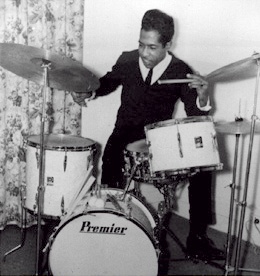
Billy Davenport and East-West
Billy Davenport started playing drums in 1939 at the age of six,
when he found a set of drumsticks in his South Side Chicago
neighborhood.
A child prodigy, he was blessed with parents that were extremely
supportive of his talents, and during the next 20 years he pursued
life as a jazz drummer in groups in high school and the armed
forces, intermixed with straight gigs with small swing combos
that played Chicago’s active jazz scene.
“I grew up on Benny Goodman and Gene Krupa,” Davenport
says. “In my neighborhood there were all kinds of clubs,
so I got to hear Billy Eckstine’s big band, Billie Holiday,
Charlie Parker — all those people. At the Persian Ballroom
— I think it was 50 cents to get in — everyone played
there.” Davenport was also very into Art Blakey and Max Roach.
“I saw Gene Ammons and once got into a jam session with Sonny
Stitt.”
But by the mid-1950s a change was underway in Chicago — jazz
was waning. “I realized around then that you couldn’t
make it in jazz unless you got with a big band. So I fell to the
blues. Like a guy told me one time, ‘Take what you know and
add to it, and it’ll come out alright.’ ”
By 1961 he was married and playing with Otis Rush. “I played
with Otis for about a year, and then I went with a harmonica player
named Little Mack Simmons, and through him I made contact with
Little Walter. I used to sit in and play with him at his gig after
I finished up with Little Mack Simmons. But Walter never liked
me too much. He said I did too many rolls — the kind of blues
he played wasn’t it.” Other gigs with Junior
Wells, Syl Johnson and again with Rush followed. “Then around
the end of 1964 I met this young man named Paul Butterfield. I
was working at Pepper’s Lounge and he’d come down and
we’d talk, but he never sat in until one Tuesday night —
jam night.”

“But it wasn’t Butterfield that got me in the band —
it was Mike Bloomfield. He came down one night, and we talked
for about an hour. He said some things were going on with the
band, and he wanted to know if I was available. I said yes, but
I didn’t know I wouldn’t like the road so much. In early
1965 they were working at Big John’s, and I sat in with the
band once, but Sam Lay was still with the band. Later that year,
after they came back from the Newport Festival, Paul and Elvin
came down — I was working with Jr. Wells — and talked
to me about playing with them. They said they were playing more
of a rock groove or swing groove. I said, ‘Call me.'”
The call came sooner than expected. Sam Lay became ill in late
1965 in Boston, and was hospitalized in Chicago. “They called
me on a Friday night where I was working at Pepper’s. They
said they were going on the road, and there was a chance to make
some real money; at that time I was making around $45 per weekend,
and the pay wasn’t working out. Paul called me about five
times that night, and we talked and I asked him one question —
could I bring my wife. Paul said, ‘You can bring your wife
or your whole family, but we need you.’ So on Monday
morning we drove up to Detroit. We rehearsed three numbers that
their drummer couldn’t do, and Paul said, ‘That’s
it. He’s the drummer.’ We left almost immediately for
Hollywood, California.”
During the Boston gig the band had started playing a long improvisation,
loosely titled “The Raga,” which was soon named “East-West.”
“We were listening to a widening range of music,” recalls
Naftalin, “including Indian classical music, particularly
that of Ravi Shankar,” which obviously impressed Bloomfield.
Soon he announced he had had a revelation with respect to Indian
music and that he understood how it worked. The band began performing
“The Raga.”
“This song was based, like Indian music, on a drone,”
explains Naftalin. “In Western musical terms it ‘stayed
on the one.’ The song was tethered to a four-beat bass pattern
and structured as a series of sections, each with a different
mood, mode and color. Every section ended with a big build-up
of eighth note accents and a climactic break. Some, but not all,
of the sections began peacefully and floated along for awhile
before building to the break. In each section the soloist chose
the mode, and throughout the song the drummer contributed not
only the rhythmic feel but much in the way of tonal shadings,
using mallets as well as sticks on the various drums and the different
regions of the cymbals.
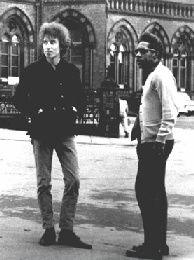
“The first section was Elvin’s solo; he set the mood
for the piece. Starting with the second section Michael played
lead on a series of sections where he explored different modes,
or scales, some of which were suggestive of Indian or Arabic music
and some of which were North American, as in blues, country &
western or Mexican.
“In places Elvin played tamboura-like drones, especially
where Mike was experimenting with quasi-Eastern sounds. Elsewhere
Elvin played rhythm parts and counter-melodies behind Mike. In
some sections the two of them played parts that I would call
double-leads.
In the last section Paul came in with his solo, driving the tune
into the final climax, which included harmonica and guitars at
full wail and ‘Joy to the World’ on the organ in multiple
octaves, capped on occasion by a series of musical ‘amens.’
This was a group improvisation. In its fullest flower it lasted
over an hour.”
Certainly the “flowering” of East-West, and of the Butterfield
band’s expanding musical repertoire, accelerated exponentially
with the addition of Davenport, a percussionist who could
handle many styles and color and decorate long, improvised passages,
something unheard of among blues drummers. Those close to the
band, like Allen Bloomfield, heard the immediate impact Davenport
had on the overall sound and musical direction.

“Sammy Lay came from an R&B background, and as great
as he was, he was more straight ahead. ‘Mojo’ and those
songs were quite different from ‘East-West’; Davenport
was more refined, more delicate. He was very competent.
It’s possible that ‘East-West’ wouldn’t have
happened without him, because he is the source of movement in
the song. Billy was so articulate. He was a good jazz drummer
and had heard a lot of those guys, especially Max Roach. He was
just so refined.”
In the early 1950s, when Muddy Waters and other first-generation
electric bluesmen plugged in and amplified their rural blues,
there was no such thing as a “blues drummer.” Muddy
pulled Fred Below from Chicago’s jazz circles and Below’s
style set the format for blues drummers from that point forward.
Late in the ’50s Muddy brought in Francis Clay, another jazz
drummer who reinvigorated blues rhythms. Now, nearly a decade
later, Butterfield had injected the skills of Davenport, stewing
even more jazz percussion back into the mix, opening up the music
to improvisation as never before. If Below was the first great
jazz drummer in blues and Clay the second, Davenport was certainly
the third, and his playing expanded the role of drummer to even
greater heights.
“Paul never told me what to play,” Davenport says. “He
just said to play what I felt was best and try what I wanted.
I’d never heard the band when I joined, just been in a jam
with them. But when we got to California we spent a week rehearsing,
and spent a lot of time on this thing called ‘East-West.’
It took a while for me to find out what I was going to do —
it was a strange rhythm thing. I first tried to play with a jazz
beat, and that didn’t work. They kept telling me it wasn’t
a rock beat or a jazz beat, but in-between — and I didn’t
know what the hell in-between was. Then it dawned on me that there
was one thing that might work, and that was bossa nova. And that
became the pattern for what I played; it started with bossa nova,
and I turned it around some and added some things.
“Nobody was playing like that in those days.”
The Maturation of a Leader.
As the band grew and its performances began to garner rave reviews,
Butterfield was also opening up. When he started the band in the
early 1960s, his hard attitude and physical and psychological
intimidation seemed molded on the “stone leader” concept
of band leaders like Howlin’ Wolf and Little Walter. “Paul
was very temperamental,” Lay told a radio interviewer. “He
never did nothing to me, but he would go off on someone else in
the band, and I’d have to settle him down.” And as a
stone leader, Butterfield was taking a bigger share of the money.
But by the time the second Elektra album, East-West, appeared,
all that had changed. Conversation and confrontations within the
band had led to a more democratic unit, both financially and musically.
Everyone was urged to contribute. Butter was no longer always
the center of the show. Bishop and Bloomfield were both singing,
while Bishop’s musical style was allowed to grow and find
definition. At some shows Bloomfield stunned the audience by eating
fire: In 1995 Al Kooper told Bloomfield Notes that the
fire-eating was “as exciting as Hendrix setting his guitar
on fire or Townshend smashing his guitar.” “East-West,”
significantly toned down for the album, became a showpiece for
the guitarists, and a full-blown musical exploration for all involved.
Butterfield had evolved from the approach of Wolf to that of Muddy,
his mentor and great friend. Wolf was the hardened leader, barking
orders to his troops, the headliner with a back-up band. Muddy
more often took the paternalistic approach — the leader who
let his troops run with their musical abilities, the one who knew
the value of a long-time relationship between his musicians and
his music.
Butterfield, by letting go of his ego and establishing equality
in the group, unleashing his players, and by pushing his musicians
to be better while soliciting their input, was expanding the scope
of the blues band in the 1960s, much as Muddy had done with his
seminal bands of the early 1950s. His own singing and instrumental
prowess had also grown beyond that of any living harp player.
For proof, listen to The Lost Elektra Sessions, then to
East-West: On the former you hear a leader with sidemen,
on the latter a cohesive ensemble with shifting personnel in the
traditional frontman/leader’s role. Butter’s singing
is markedly different, stronger. His playing is incredible.
The Butterfield Band had become a great band– and certainly
no longer just a blues band. Butterfield was becoming a complete
musician with a very effective style of leadership. Both were
about to take on a new role they could never have imagined.

The Paul Butterfield Blues Band
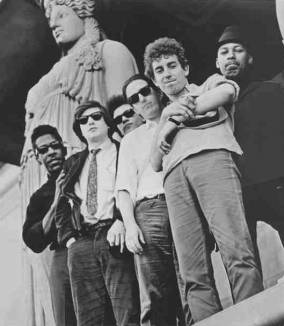
was one of those rare ensembles that were soulful, charismatic and
incredibly influential. Two major players stood out as soloists in the
group; Paul Butterfield, a talented harmonica player and vocalist, and
Michael Bloomfield on electric guitar. On East West both get a
chance to display expressive originality. The contrast between
Bloomfield and Elvin Bishop’s more traditional solos are nothing short
of spectacular.
Butterfield was born and raised in Chicago’s Hyde Park neighborhood.
As a teenager, he studied flute and later developed a love for the blues
harmonica. Teaming up with the blues loving Elvin Bishop, they both began hanging around musicians
such as Muddy Waters, Howlin’ Wolf, and Junior Wells. Forming a band with Jerome Arnold and Sam
Lay and Bloomfield they began introducing the blues to a whole new
audience. The band was then signed by Elektra Records.
Butterfield and Bloomfield composed the title track East West.
This tune would create a unique shift in music history. It was more of a
jazz eastern Indian raga piece with long improvisational solos by
members of the band. At this point in time no one heard much of the
sitar in blues, but Bloomfield manipulated his guitar to create a sound
that was totally unique at the time. Butterfield complimented Bloomfield
with a distinctive harmonica sound of his own… When The Paul
Butterfield Blues Band played at The Fillmore in San Francisco in the
summer of 1966, the word spread and dozens of local bands followed in
the style of East West; helping to create the psychedelic sound
of Haight Ashbury.
East West was never commercially successful, but it was
critically acclaimed. I’ve listened to it several times lately, and
considering this album came out in 1966, it sounds fresh and unique even
today. The Paul Butterfield Blues Band was indeed revolutionary and
created a sound that emerged as the dominant rock music of the late
1960s.

Paul Butterfield (17 December 1942 – 4 May 1987) was an American
blues vocalist and harmonica
player, who founded the Paul Butterfield Blues Band in the early 1960s
and performed at the original Woodstock Festival. He died of drug-related heart failure.
Career
The son of a lawyer, Paul Butterfield was born and raised in
Chicago’s Hyde Park neighborhood.,
where he attended the University of Chicago
Laboratory Schools, a private school associated with the University
of Chicago. After studying classical flute with Walfrid Kujala of the Chicago Symphony Orchestra as a teenager,
he developed a love for the blues harmonica, and hooked up with white,
blues-loving, University of Chicago physics student
Elvin Bishop (“Fooled Around and Fell in Love“).
The pair started hanging around black
blues musicians
such as Muddy Waters, Howlin’
Wolf, Little Walter and Otis
Rush. Butterfield and Bishop soon formed a band with Jerome Arnold
and Sam Lay (both of Howlin’
Wolf‘s band). In 1963, the
racially mixed ensemble was made the house band at Big John’s, a folk
music club in the Old Town district on Chicago’s north
side. Butterfield was still underage (as was guitarist Mike Bloomfield.) Butterfield played Hohner harmonicas,
in particular the ‘Marine Band’ model, which he held in his left hand.
Butterfield Blues Band
The Paul Butterfield Blues Band was signed to Elektra Records after adding Bloomfield as lead
guitarist.
Their original debut album was scrapped, then re-recorded after the
addition of organist Mark
Naftalin.
Some of the discarded tracks appeared on the What’s Shakin LP shared with the Lovin’ Spoonful. Their self-titled
debut, The Paul Butterfield
Blues Band, containing Nick Gravenites‘ “Born in Chicago,” was released in
1965.
At the Newport Folk Festival of 1965, Bob
Dylan closed the event backed by Butterfield’s amplified band
(without Butterfield himself, however), a move considered controversial
at the time by much of the folk music establishment.
After the release of The Paul Butterfield Blues Band, Lay
became ill with pneumonia and pleurisy and Billy
Davenport took over on drums. The Butterfield Band’s second album
was 1966’s East-West.
Mike Bloomfield quit the band and formed The Electric Flag with Gravenites, and Bishop began
playing lead guitar on The Resurrection of Pigboy
Crabshaw (1967). The band now included saxophonists David
Sanborn and Gene Dinwiddie, bassist Bugsy Maugh, and drummer Phillip Wilson.
The Butterfield Blues Band played the Monterey
International Pop Festival along with The Electric Flag, Jimi
Hendrix, Ravi Shankar, and many others.
After 1968’s release In My Own Dream, both Bishop and Naftalin
left at the end of the year. Nineteen-year-old guitarist, Buzzy Feiten, joined the band on its 1969
release, Keep On Moving, produced by Jerry Ragavoy, and Rod Hicks replaced Maugh on
bass. The Butterfield band played at the Woodstock Festival, although their performance wasn’t
included in the resulting Woodstock film. In 1969,
Butterfield also took part in a concert at Chicago’s Auditorium Theater
and a subsequent recording session organized by record producer Norman
Dayron, featuring Muddy Waters and backed by pianist Otis
Spann, Michael Bloomfield, Sam Lay, Donald “Duck” Dunn, and Buddy
Miles, which was recorded and portions
released on Fathers And Sons on Chess
Records.
Better Days
Following the releases of Live in 1970 and Sometimes I Just
Feel Like Smiling in 1971, Butterfield broke up the horn band with David
Sanborn and Dinwiddie, and returned to Woodstock, New York.
He formed a new group including Chris Parker on drums, guitarist
Amos Garrett, Geoff
Muldaur, pianist Ronnie
Barron and bassist Billy Rich, naming the ensemble “Better
Days.” The group released Paul Butterfield’s Better Days and It
All Comes Back in 1972 and 1973, respectively.
In 1976, Butterfield performed at The Band‘s
final concert, The Last Waltz. Together with The Band,
he performed the song “Mystery
Train” and backed Muddy
Waters on “Mannish Boy“.
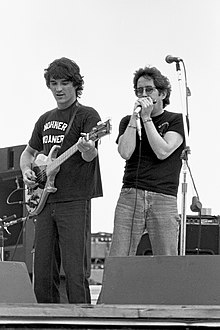
With Rick Danko, (left) on bass guitar. Woodstock Reunion,
Septenber 7, 1979
Solo
The late 1970s and early 1980s saw Butterfield as a solo act and a session musician, doing occasional television
appearances and releasing a couple of albums. He also toured as a duo with Rick
Danko, formerly of The Band, with whom he performed for the last time
in Pittsburgh, Pennsylvania.
He also toured with another member of The Band, Levon
Helm, as a member of Helm’s “RCO All Stars”, which also included
most of the members of Booker T and the MGs, in 1977. In
1986 Butterfield released his final studio album, The Legendary Paul Butterfield Rides Again.
Harmonica style
Butterfield played and endorsed (as noted in the liner notes for his
first album) Hohner harmonicas,
in particular the diatonic ten-hole ‘Marine Band’ model. He played
using an unconventional technique, holding the harmonica upside-down
(with the low notes to the righthand side). His primary playing style
was in the second position, also known as cross-harp, but he also was
adept in the third position, notably on the track East-West from
the album of the same name, and the track ‘Highway 28’ from the “Better
Days” album.
Seldom venturing higher than the sixth hole on the harmonica,
Butterfield nevertheless managed to create a variety of original sounds
and melodic runs. His live tonal stylings were accomplished using a
Shure 545 Unidyne III hand-held microphone connected to one or more Fender amplifiers,
often then additionally boosted through the venue’s public address (PA)
system. This allowed Butterfield to achieve the same extremes of volume
as the various notable sidemen in his band.
Butterfield also at times played a mixture of acoustic and amplified
style by playing into a microphone mounted on a stand, allowing him to
perform on the harmonica using both hands to get a muted, Wah-wah effect, as well as various vibratos.
This was usually done on a quieter, slower tune.
Death
Paul Butterfield died from heart fauliure due to an overdose of drugs
on May 4, 1987
at his home in North Hollywood,
California. A month earlier, he was featured on B.B. King &
Friends, a filmed concert that also included Albert
King, Stevie Ray Vaughan, Etta
James, Gladys Knight and Eric
Clapton. Its subsequent release was dedicated to Butterfield in
memoriam.
In 2005, the Paul Butterfield Fund and Society was founded; one of
their aims is to petition for Butterfield’s inclusion in the Rock and
Roll Hall of Fame.

